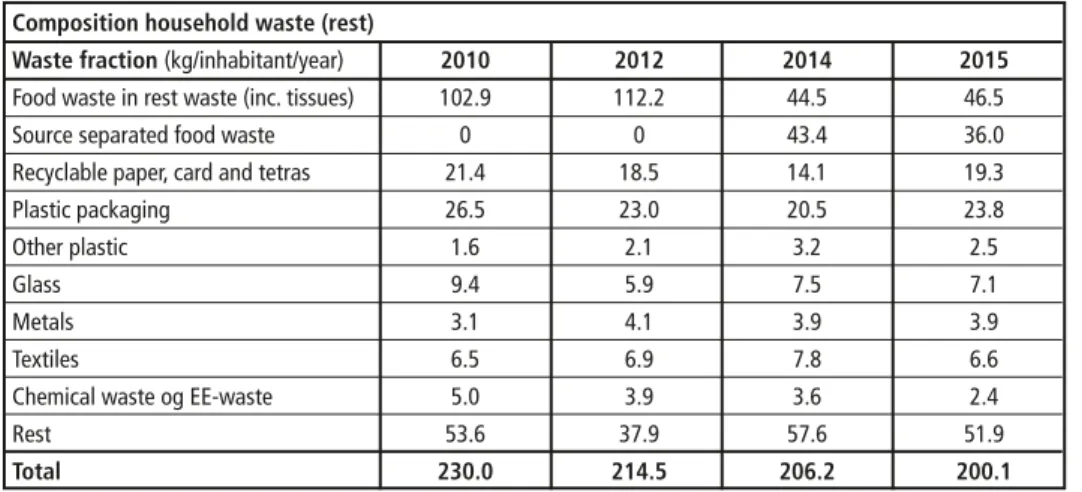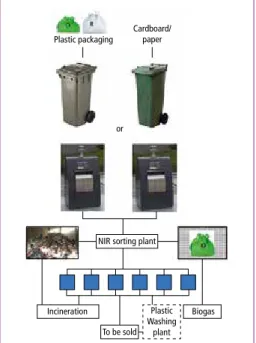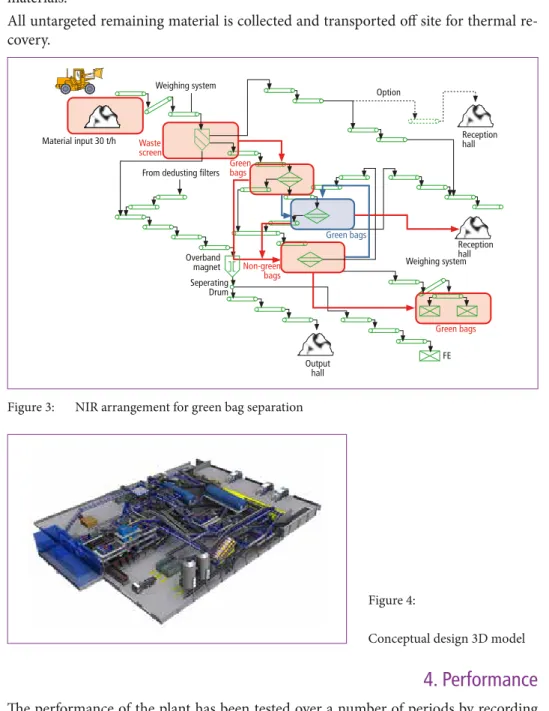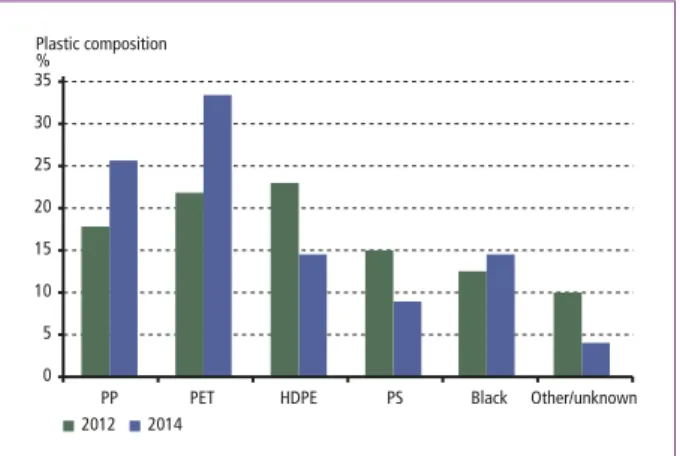MBT and SRF
Fully Automated Sorting Plant for Municipal Solid Waste in Oslo with Recovery of Metals, Plastics, Paper
and Refuse Derived Fuel
Benjamin Eule
1. Technical brief and solution ...356
1.1. Input waste composition ...356
1.2. Throughput ...357
2. Output quality ...357
3. Design ...358
4. Performance ...359
5. Plant upgrade ...360
6. References ...361 In order to treat household waste Romerike Avfallsforedling (ROAF) located in Skeds- morkorset north of Oslo, Norway required the installation of a mechanical treatment facility to process 40,000 tpa. Together with a Norwegian based technical consultancy Mepex and German based technical consultancy EUG the project was tendered and the plant build against a technical specification. In 2013 the project was awarded to Stadler Anlagenbau and since April 2014 the plant is in operation with an hourly throughput of thirty tons. The input waste contains specific green coloured bags containing food waste which is collected together with the residual waste from the households. The process recovers successfully the green food bags before the remaining waste is mechanically pre-treated and screened to isolate a polymer rich fraction which is then fully segrega- ted via NIR technology in to target polymers prior to fully automated product baling.
Recoverable Fibre is optically targeted as well as ferrous and non-ferrous metals. All food waste is transported off site for further biological treatment and the remaining residual waste leaves site for thermal recovery. In 2015 the plant has been successfully upgraded to forty tons per hour and remains fully automated including material baling.
Project location – ROAF The facility owner and operator is Romerike Avfallsforedling (ROAF) who currently owns and treats the waste of 10 municipalities around Oslo. These are Enebakk, Fet, Gjerdrum, Lørenskog, Nittedal, Rælingen, Skedsmo, Sørum, Aurskog-Høland and Rømskog. Together the municipalities represent 193,000 residents. There is a weekly
MBT and SRF
collection of food waste and residual waste. Altogether there are 180 recycling points (bring systems) for glass and metal packaging. A four weekly paper collection round is also offered to the residents. Figure 1 below shows the waste quantities available to ROAF.
Site and ambitions
On the same site of an existing infrastructure for house hold waste recycling and an existing landfill, a dedicated new building was designed for the new facility. In order to maximise energy recovery, the building heating system for the processing hall is using heat recovery provided from the air compressors required for the recycling process.
The majority of the waste is collected directly from refuse collection vehicles picking up the waste directly from the households.
104,000 tons waste in total
80,000 tons householde waste
40,000 tons to sorting plant
10,000 tons paper waste in own bin
30,000 tons recycling stations
6,000 tons food waste in
green bags 24,000 tons
industrial waste
Figure 1: Waste quantities available to ROAF
Source: Brevik: ROAF Business Presentation. July 2016
Stadler Anlagenbau’s involvement started with submitting a tender for the design and build of the process against a specification prepared by Norwegian based technical consultants MEPEX and German based technical consultants EUG.
1. Technical brief and solution
The overarching requirement for the process was to treat the waste without any manual labour other than feeding the plant and removing product and final residue.
The plant input consists of residue waste combined with food waste which is bagged by the residents in specific green bags provided by the waste municipality. A further characteristic of the household waste is, that its bagged content is extremely high, so that it is important to open the bags in order to recover the valuable recyclates con- tained within.
1.1. Input waste composition
The anticipated split between green (organic) waste bags and residue waste was appro- ximately 20:80. Once the green bags would be removed a possible waste composition is as shown in Table 1 and also its changes post construction of the facility.
MBT and SRF
Data from 2010 and 2012 shows food waste within rest waste, but since 2014 food is collected separately in green bags and as a result the figure reduces. Overall the total waste produced reduces within the five year period from 2010 to 2015 by 13 percent from 230 kg/inhabitant and year to around 200 kg/inhabitant and year.
1.2. Throughput
The initial design plant throughput of the facility was thirty tons per hour with a me- chanical availability of 85 percent. Plant capacity tests have shown that the plant can operate at higher than 38 tons per hour whilst still achieving plant availability of lager than 85 percent. During a plant upgrade in autumn 2015 the plant throughput has been increased to forty tons per hour. For both of these figures the plant throughput includes the weight of the green bags (food waste).
Table 1: Design waste input composition Composition household waste (rest)
Waste fraction (kg/inhabitant/year) 2010 2012 2014 2015 Food waste in rest waste (inc. tissues) 102.9 112.2 44.5 46.5
Source separated food waste 0 0 43.4 36.0
Recyclable paper, card and tetras 21.4 18.5 14.1 19.3
Plastic packaging 26.5 23.0 20.5 23.8
Other plastic 1.6 2.1 3.2 2.5
Glass 9.4 5.9 7.5 7.1
Metals 3.1 4.1 3.9 3.9
Textiles 6.5 6.9 7.8 6.6
Chemical waste og EE-waste 5.0 3.9 3.6 2.4
Rest 53.6 37.9 57.6 51.9
Total 230.0 214.5 206.2 200.1
Source: Fredrikson: MEPEX, Presentation. April 2016
Purity Recovery
% % Category Contract Contract
Green Bags 97 95
Ferrous 0 – 60 mm (< 100) 90 95 Ferrous > 60 mm (> 100) 88 95
Non Ferrous 85 85
Polymers 75 90
PET 97 90
PP 97 80
PE Containers 97 85
PE Film 96 80
Paper 95 85
Table 2: Output product quality require- ments
2. Output quality
Parameters for the output quality are fo- cusing primarily on Polymers and Metals.
The process is set out to recover polymers (film and rigid) early in the process and then use ballistic and optical separation to isolate target polymers without the need of manual quality control. The following parameters were required to be achieved whilst the plant was operated at its design throughput and values for purity and recovery are shown in Table 2.
MBT and SRF
3. Design
As basis of the plant and process design it needed to be considered first how the waste is collected and presented to the facility, second what the main outputs and products (available markets) would be available and third that the process was as fully automated as possible.
Figure 2 shows that the input waste is from household collection via wheelie bins and that it contains refuse with an element of plastics and food waste in green bags. A key requirement was therefore to isolate the green bags containing food waste from the mix of input material before trying to mechanically recover the valuable plastics contained within the refuse bags.
This is achieved by screening the input waste with the least amount of impact to isolate the green bags as much as possible before they are exposed to valve blocks selecting the green bags based on near infrared detection. Two units in series are positively targeting green bags to maximise recovery, whereas a third unit is cleaning the combined flows from unit one and two positively to increase purity of the green bag fraction. The bags are then stored in roro bins and transported off site for further organic treatment processes.
The process is further illustrated in Figure 3.
Plastic packaging Cardboard/
paper
or
NIR sorting plant
Incineration Plastic
Washing plant
Biogas To be sold
With the food waste (green bags) removed it is now possible to prepare the remaining waste more aggressively in order to make recyclates such as polymers, fibre and metals available. This is achieved with a combination of bag openers, shredders and trommel screens which are also sizing the material to isolate recoverable material from residue.
After the mechanical preparation and pre sorting Tomra NIR technology is used to remove target polymers, such as of film and rigid plastic whilst suppressing unwanted material containing parts or composites of polymers, such as textiles, nappies and composite plastics. The isolated polymers are then further segregated via ballistic se- paration technology from Stadler into 2D polymers – such as film and flat packaging – and 3D polymers – such as plastic bottles and rigid packaging. Once isolated, the Figure 2: Waste collection principle
Source: Fredrikson: MEPEX, Presentation. April 2016
polymers cascade through a two stage optical sortation for either positive/positive for the 2D or positive/negative for the 3D materials. Products are then conveyed directly to fully automated storage bunkers without any quality control picking or manual inter- vention. Based on weighing information and volume calculation the product baler calls automatically for bunker material and produces only full bales with the correct length.
MBT and SRF
Medium size – larger than 120 mm – material that has not been targeted by the polymer sorters flows through a 2 stage NIR assembly to recover paper before metal recovery in form of overband magnets and eddy current separation in order to recover non-ferrous materials.
All untargeted remaining material is collected and transported off site for thermal re- covery.
Figure 3: NIR arrangement for green bag separation
4. Performance
The performance of the plant has been tested over a number of periods by recording daily plant activity logs and product mass balance assessments. Product recovery has been calculated via mass balance recordings combined with product and non product material analysis to establish purity.
Figure 4:
Conceptual design 3D model
Material input 30 t/h
Weighing system
Weighing system Waste
screen
Option
Reception hall
Reception hall
Output hall
FE Seperating
Drum Overband
magnet From dedusting filters
Green bags
Green bags Non-green
bags Green bags
MBT and SRF
Table 3: Product purities results June 2014/
December 2015
Test December 2015 Guarantee Measured
% %
PE Film* 96 96.3
HDPE 97 97.2
PP 97 97.6
PET 97 97.2
Magnetic metal* 90 94.1 Non magnetic metal* 85 94.1 Paper/card/tetra* 95 96.2
* Test June 2014
Test December 2015 Guarantee Measured
% %
PE Film 72 83.6
HDPE, Total 60 79.8
PP, Total 65.7
PP bottle 68 69.2
PP flat 45 51.7
PET, Total 65.4
PET bottle 68 70.1 PET trays 45 62.1 Magnetic metal* 95 98 Non magnetic metal* 1) 85 80 Paper/card/tetra No 52 Jan. to Febr. 2016 guarantee
1) EC adjusted due to plastic packaging
Table 4: Product recovery results June 2014/
December 2015
The data [3, 4] shown above in Table 3 and Table 4 shows that all required guarantees have been met by the process. The slightly measured deviation in the recovery cal- culation of non-ferrous metal is a result
of including the non-ferrous content of multilayer metallic layers within some of the plastic packaging.
Mechanical plant availability was measured around 95 percent over the testing period with throughput constantly exceeding thirty tons per hour which satisfied the required guarantees from the design brief.
5. Plant upgrade
In 2015 the decision was taken to further upgrade the plant to increase its capacity to forty tons per hour. This was triggered by the potential to have more input waste available to the facility and by a discovered change of rigid polymers in the waste from 2012 to 2014 as shown in Figure 5. In particular PP and PET had increased whilst HDPE, PS and Other were decreasing.
PET HDPE PS Black Other/unknown
35 30 25 20 15 10 5
Plastic composition
%
PP 2012 2014 0
Figure 5:
Rigid plastic composition 2012 and 2014
Source: Fredrikson: MEPEX, Presenta- tion. April 2016
MBT and SRF
In order to increase the throughput a second bag opener was added to the system to- gether with an additional screen for fines material to recover smaller rigid plastic and a wind shifter to balance plastic film volume.
6. References
[1] Brevik: ROAF Business Presentation. July 2016 [2] Fredrikson: MEPEX, Presentation. April 2016
[3] Frederikson; Ostermann; Eule et al.: MEPEX, Presentation. April 2016
[4] Stadler Anlagenbau: Performance Test Report 2 and 3, June 2014 and December 2015
Dorfstraße 51
D-16816 Nietwerder-Neuruppin
Tel. +49.3391-45.45-0 • Fax +49.3391-45.45-10 E-Mail: tkverlag@vivis.de
www.
.de
TK Verlag Karl Thomé-Kozmiensky
Wir widmen uns aktuellen verfahrens- und anlagentechnischen sowie politischen, rechtlichen und wirtschaftlichen Themen, soweit sie die Abfall- und Kreislaufwirtschaft, die Energie- und Rohstoffwirtschaft und den Immissionsschutz betreffen.
Unsere Aufgabe sehen wir in der Kommunikation zwischen Politik, Verwaltung, Wirtschaft, Technik und Wissenschaft.
Zu wichtigen Themen veranstalten wir Konferenzen und Congresse – dazu geben wir Bücher heraus.
Stets sind wir auf der Suche nach interessanten Referenten, aktuellen Themen und spannenden Projekten um unser Angebot weiterzuentwickeln. Gern lassen wir uns von neuen Ideen inspirieren und diskutieren deren Realisierbarkeit.
Der TK Verlag gibt seit dreißig Jahren Fachbücher zu zahlreichen Themen des technischen Umweltschutzes heraus:
Unsere Konferenzen im Überblick:
• Berliner Abfallwirtschafts- und Energiekonferenz
• Berliner Recycling- und Rohstoffkonferenz
• Berliner Konferenz
Mineralische Nebenprodukte und Abfälle
• IRRC – Waste-to-Energy
• Berliner Immissionsschutzkonferenz
• Thermische Abfallbehandlung und energetische Verwertung
• Mechanisch-biologische Abfallbehandlung und Ersatzbrennstoffe
• Biologische Abfallbehandlung
• Recycling und Rohstoffe
• Verpackungen, ...
Insgesamt sind bislang bei uns etwa zweitausend Fachbeiträ- ge erschienen, die in ihrer Gesamtheit einen guten Überblick über technische, wirtschaftliche, rechtliche und politische Entwicklungen geben. Seit Kurzem stellen wir Ihnen die Fachbeiträge kostenlos auf unserer Internetseite zur Verfügung.
Thomé-Kozmiensky + Goldmann Recycling und Rohstoffe Band 7
Thomé-Kozmiensky und Beckmann Energie aus Abfall 11 Thomé-Kozmiensky und Beckmann Energie aus Abfall 11
Thomé-Kozmiensky + Goldmann Recycling und Rohstoffe Band 5 Karl J. Thomé-Kozmiensky und Andrea Versteyl • Planung und Umweltrecht 6Karl J. Thomé-Kozmiensky und Andrea Versteyl • Planung und UmweltVersteyl • Planung und UmweltVrecht 6
IMMISSIONSSCHUTZ 2
Thomé-Kozmiensky Dombert,
Versteyl, Rota
rd, Appel
4K. J. Thomé-Kozmiensky & S. Thiel WASTE MANAGEMENT 4
K. J. Thomé-Kozmiensky & S. Thiel WASTE MANAGEMENT
Karl J. Thomé-Kozmiensky Strategie Planung Umweltr echt 8
Besuchen Sie uns unter
Thomé-Kozmiensky + Goldmann Recycling und Rohstoffe Band 4
Bibliografische Information der Deutschen Nationalbibliothek Die Deutsche Nationalbibliothek verzeichnet diese Publikation in der Deutschen Nationalbibliografie; detaillierte bibliografische Daten sind im Internet über http://dnb.dnb.de abrufbar
Thomé-Kozmiensky, K. J.; Thiel, S. (Eds.): Waste Management, Volume 6 – Waste-to-Energy –
ISBN 978-3-944310-29-9 TK Verlag Karl Thomé-Kozmiensky
Copyright: Professor Dr.-Ing. habil. Dr. h. c. Karl J. Thomé-Kozmiensky All rights reserved
Publisher: TK Verlag Karl Thomé-Kozmiensky • Neuruppin 2016
Editorial office: Professor Dr.-Ing. habil. Dr. h. c. Karl J. Thomé-Kozmiensky,
Dr.-Ing. Stephanie Thiel, M. Sc. Elisabeth Thomé-Kozmiensky, Janin Burbott-Seidel und Claudia Naumann-Deppe
Layout: Sandra Peters, Anne Kuhlo, Janin Burbott-Seidel, Claudia Naumann-Deppe, Ginette Teske, Gabi Spiegel und Cordula Müller
Printing: Universal Medien GmbH, Munich
This work is protected by copyright. The rights founded by this, particularly those of translation, reprinting, lecturing, extraction of illustrations and tables, broadcasting, micro- filming or reproduction by other means and storing in a retrieval system, remain reserved, even for exploitation only of excerpts. Reproduction of this work or of part of this work, also in individual cases, is only permissible within the limits of the legal provisions of the copyright law of the Federal Republic of Germany from 9 September 1965 in the currently valid revision. There is a fundamental duty to pay for this. Infringements are subject to the penal provisions of the copyright law.
The repeating of commonly used names, trade names, goods descriptions etc. in this work does not permit, even without specific mention, the assumption that such names are to be considered free under the terms of the law concerning goods descriptions and trade mark protection and can thus be used by anyone.
Should reference be made in this work, directly or indirectly, to laws, regulations or guide- lines, e.g. DIN, VDI, VDE, VGB, or these are quoted from, then the publisher cannot ac- cept any guarantee for correctness, completeness or currency. It is recommended to refer to the complete regulations or guidelines in their currently valid versions if required for ones own work.




